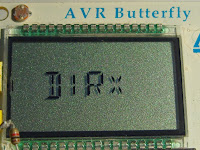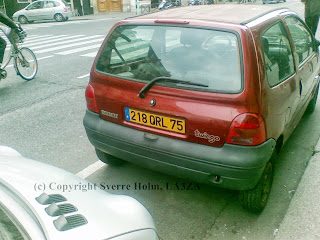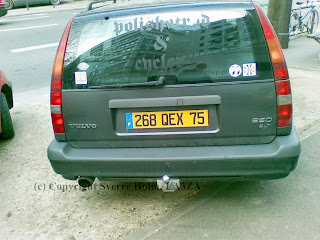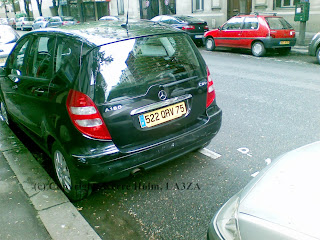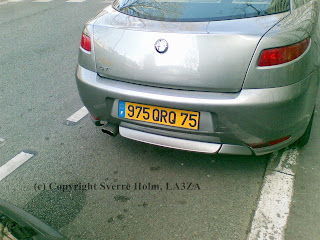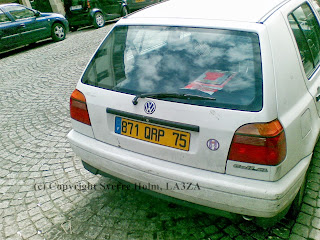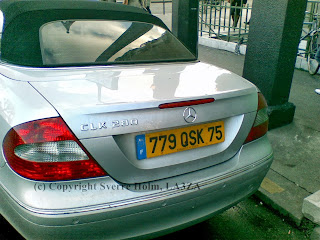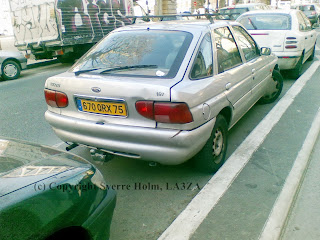Posts Tagged ‘Morse’
 Single-lever and ultimatic adapter
Single-lever and ultimatic adapter
 |
| Photo @LA3ZA |
Here’s an adapter that emulates both a single-lever paddle mode and the ultimatic mode. It is meant to go between a dual-lever paddle and an iambic keyer. The adapter has been implemented in an AVR Butterfly in C and it is compatible with Morse keyers such as the one in the Elecraft K3 and the K1EL WKUSB. The single-lever emulation is probably the most novel part and it is meant to make it easier to practice single-lever keying on a dual-lever paddle.
When pressing both paddles in the ultimatic mode the last one to be pressed takes control, rather than the alternating dit-dah or dah-dit of the iambic mode. The five possible states are then (from “An ultimatic adapter for iambic keyers“, Kevin E. Schmidt, W9CF, 2008):
- Lin = 1, Rin = 1 => Lout = 0, Rout = 0.
- Lin = 1, Rin = 0 => Lout = 0, Rout = 1.
- Lin = 0, Rin = 1 => Lout = 1, Rout = 0.
- Lin = 0, Rin = 0 after Lin = 1, Rin = 0 => Lout = 1, Rout = 0.
- Lin = 0, Rin = 0 after Lin = 0, Rin = 1 => Lout = 0, Rout = 1.
The left and right inputs are Lin and Rin and an open input is “1” and a closed one is “0” since the key grounds the input. The output is “1” when it is on and “0” when it is off. The adapter makes it possible with this mode on your favorite keyer where you may have missed this mode.
When I implemented the ultimatic adapter after W9CF’s instructions, it struck me that it would be both useful and easy to add an emulator for a single-lever paddle also. When both keys are pressed in this mode, the last one to be pressed is ignored. This gives the following inverted outputs in states 4 and 5:
- Lin = 0, Rin = 0 after Lin = 1, Rin = 0 => Lout = 0, Rout = 1.
- Lin = 0, Rin = 0 after Lin = 0, Rin = 1 => Lout = 1, Rout = 0.
The code also has a direct mode that just sends the input unchanged to the output, as well as a possibility for exchanging the right and left paddles. The display may therefore show ‘ULT, ‘SGL, ‘DIR’ and ‘ULTx’, ‘SGLx’, ‘DIRx’ for these combinations.
The exchange mode is actually quite fun to use. In general for me it is easier to swap the paddles when keying with my left hand. I don’t think I am the only one with that experience.
The C code can be found below. These days I should probably have written it for the Arduino, but the code should be easy to move. Perhaps I’ll do that myself, now that I have an Arduino Mega on order.
Many keyers have the ultimatic mode and the possibility to exchange right and left, but no keyers have the single-paddle emulation mode as far as I know. I think it is quite useful. This summer when I implemented it I thought it was novel also.
But that was before I found out that this mode actually had been proposed by Larry Winslow, W0NFU, in QST in October 2009 and that one can get an iambic to single paddle kit from WB9KZY. Oh well, “there is nothing new under the sun” as the wise man of Ecclesiastes said some 3000 years ago. Just like the ultimatic mode has been implemented in many keyers these days, let me propose the single paddle mode for implementation as a new command also.
void paddle() |
 Studies on Morse code recognition
Studies on Morse code recognition
 |
| Nice drawing of Morse key by Dutch radio amateur Dick Kraayveld, PA3ALM (http://www.morsecode.nl/pa3alm.html) |
In the early 90’s there were some interesting studies performed on Morse code recognition and the effects of pitch frequency, signal to noise ratio and code speed. They were part of the PhD work of Peter Montnémery who is a medical doctor and also radio amateur SM7CMY. I reread these papers now since there was a discussion on the pitch frequency (CW pitch resolution) just recently on the Elecraft mailing list. This discussion comes up from time to time, as it did for instance in 2006 also (Sidetone questions — copy speed vs sidetone pitch).
The two first papers are probably the most interesting ones for radio amateurs, so therefore I have posted their abstracts and a key figure from each of them also.
 |
| Press figure for larger size |
Paper 1: Montnemery, P., Almqvist, B., & Harris, S. (1991). Recognition of Telegraphy Disturbed by Noise at Different S/N-Ratios and Different Telegraphy Speeds A Comparison to Short-Tone Audiometry. Scandinavian Audiology, 20(1), 33-39.
Abstract: “The ability to recognize telegraphy at different S/N ratios and telegraphy speeds was compared for 10 normal-hearing men trained in detecting telegraphy. The ability to recognize telegraphy disturbed by noise decreased with increasing telegraphy speed and reduced S/N ratio. The recognition of telegraphy disturbed by noise seems to follow the relations known from experiments with short-tone audiometry.”
The figure above (Fig. 5) shows recognition in % vs signal to noise ratio (SNR) for speeds 13, 25, 40, 63, 82, and 103 characters per minute (CPM) which when divided by five correspond to 2.6, 5, 8, 12.6, 16.4, and 20.6 words per minute (WPM). Note how recognition at the 90 % rate is easiest (works under lowest SNR) at 5 WPM, then 8, then the exception for the slow speed 2.6 WPM, and then gets even harder at speeds 12.6, 16.4, and 20.6 WPM.
 |
| Press figure for larger size |
Paper 2: Montnemery, P., Almqvist, B., & Harris, S. (1992). Recognition of telegraphy signs at different listening levels and frequencies. Scandinavian Audiology, 21(4), 255-260.
Abstract: “The recognition of telegraphy masked by noise at 40 and 80 signs/min telegraphy speed was studied in 10 normal-hearing subjects at different sound pressure levels (25–85 dB SPL in steps of 5 dB) as well as at different test frequencies (2000, 1000, 800, 630, 500 and 250 Hz). The ability to recognize the signs varied with varying SPL. Recognition for most of the subjects was best at an SPL close to 70 dB. All subjects improved their recognition as the frequency was lowered to 500 Hz, some even at 250 Hz. These facts should be taken into consideration when training telegraphy operators as well as in the construction of radio receivers to permit listening at low frequencies. Furthermore, the critical ratio was calculated at the different test frequencies.”
The figure above (Fig. 6) shows recognition rate at different pitch frequencies at a speed of 80 CPM = 16 WPM. There is an improvement as the pitch is lowered and it more or less seems to level off at 500 Hz, except for the lowest SNRs (-13 and -14 dB) which improve at a pitch of 250 Hz. As a side note, the SNR scale must be different from that in the former figure since the values are considerably lower here.
The other papers in the thesis “Signal Detection in Noise, with special reference to telegraphy” are:
- Paper 3: This study is on the effect of stimulating each ear simultaneously with different sounds: Montnemery, P., & Harris, S. (1995). Effect of dichotic presentation on the recognition of telegraphy signs. Scandinavian Audiology, 24(1), 39-45.
- Paper 4: Montnemery, P., Almqvist, B., & Harris, S. (1995). Performance of electronic Morse decoders in decoding telegraphy masked by noise. Scandinavian Audiology, 24(1), 57-62.
- Paper 5: Montnemery, P., & Harris, S. (1995). Recognition of telegraphy in hearing-impaired telegraph operators. Scandinavian Audiology, 24(2), 107-115.
The first paper shows how lowering the speed enhances recognition when conditions are poor. Unfortunately only 250 and 500 Hz were tested in the second paper, but it should be clear that a low tone is preferable. If one were to do a follow up study, it would be interesting to zoom in on the frequencies between 250 and 500 Hz for further testing. Since 40 and 80 CPM is only 8 and 16 WPM, it would also be interesting to test at higher speeds.
 Q codes from the streets of Paris
Q codes from the streets of Paris
I had the privilege of living in Paris with my wife a few years ago. At that time, 2008/2009, the series for car license plates had just come to Q. That made it easy to find plates with many of the Q codes which are used as abbreviations in radio communications. What follows is the result of walking the streets of Paris, mostly between the 5. and the 13. arrondissement:
Here is a broadcast to all radio amateurs:
Watermarking by http://www.watermark-images.com/
 The advantage of the single-lever paddle
The advantage of the single-lever paddle
 |
| My single-lever PCB keyer KI6SN/NB6M-style |
It may seem like a bad idea to downgrade from a dual-lever paddle and iambic keyer to a single-lever paddle. It must be inefficient since each individual dash and dot has to be generated by a right or left movement of the paddle. Despite this, many of the champions in the High Speed Telegraphy competitions use single-lever paddles, often home-made ones. How can that be?
K7QO, Chuck Adams, wrote “Using an Iambic Paddle” and compared the dual-lever paddle with the single-lever with respect to number of movements. If all 26 letters of the English alphabet and the numbers from 0 to 9 are sent, the single-lever paddle requires 73 strokes while a dual-lever and an iambic keyer requires 65. This is 11% less.
But when N1FN, Marshall G. Emm, wrote “Iambic Keying – Debunking the Myth” he analyzed the 7 letters that are faster to send with an iambic keyer – C, F, K, L, Y, Q, and R – and found that only one of them, the L, is among the 12 most frequent ones in English. He illustrated it this way:
Guess what’t wrong with this figure? He didn’t see the R and forgot that it is also among the most frequent letters!
So two of the faster letters are among the most frequent ones, not just one. I guess that N1FN’s estimate of only a 5% increase in efficiency when letter frequencies are taken into account is a bit too small then. In addition comes the fact that CQ, and all Q-codes use letters that are more efficient with the iambic keyer, so in radio amateur use the efficiency advantage of the iambic keyer is probably even more than 11%.
So this doesn’t explain the fact that many of the high speed champions do so well on single-lever paddles. My experience is based on learning to send Morse code at the age of 47. Somehow I feel that this was 20-30 years too late in order to master all the finer movements involved in iambic keying.
The issue must be tolerance to errors, not just efficiency. The high-speed champions value that and increasingly the producers of morse paddles are including single-lever paddles in their assortment.
A single-lever paddle is also easy to make yourself, much easier than a dual-lever paddle. I made one from printed circuit board based on the paddles of KI6SN. That design was a modified version of the miniature single-lever paddle of NB6M. I made it just to try the concept before I move on and eventually buy one. But the homemade one was surprisingly good to use, so I might stay with it for a while. The nice thing is that the single-lever couldn’t care less if your keyer is set up for iambic A og B. Neither if the keyer does the ultimatic mode which I promoted recently (Is the ultimatic Morse keyer really that efficient?)
There should be freedom in choice of paddle, so everyone should find what suits best regardless of what is the current fashion or what it is that is considered to be ‘best’. So whether you are a newcomer who struggle with learning to send properly with an iambic keyer, or an oldtimer who keep using the dual-lever as if it is a single-lever paddle, feel free to change to a single-lever paddle. I am sure you will notice a reduced error rate.
The question for me is what “real” single-lever key I should upgrade to, they all look attractive: Begali, Bencher, Bushwhacker, Hi-Mound, Kent, K8RA, N3ZN, Scheunemann, UR5CDX, Vibroplex, …
 Is the ultimatic Morse keyer really that efficient?
Is the ultimatic Morse keyer really that efficient?
 |
| Vintage Ten-Tec Ultramatic Keyer KR50. Nice name but the similarity to ultimatic seems to be coincidental. |
Iambic keying with a dual-lever paddle is by far the most popular form for Morse keying. But in recent years an old alternative has reemerged. This is the Ultimatic mode which goes back to W6SRY in the 1950’s.
The experience seems to be that it needs less timing precision than the iambic mode for letters like A, N, R, and K (· —, — ·, · — ·, — · —). When both paddles are squeezed, the last one to be pressed takes control. So when right-left is pressed one gets a dah followed by dits, not the dah-di-dah-dit of the iambic keyer.
It is very simple to add code for an ultimatic keyer to an iambic one. In recent years this has led to an ultimatic option in some stand-alone keyers, such as:
- Several of the keyers from Jackson Harbor Press, WB9KZY, like the PK-4.
- Several of the newer K1EL keyers, like the K14 which also has modes for dah priority, dit priority, and bug.
- The ultimatic kit from Elektor.
I have yet to hear of a single integrated keyer in a rig that supports the ultimatic mode, and that is probably why from time to time a request for a software upgrade to the Elecraft rigs is sent to the Elecraft reflector. If you really want that, and you don’t want to use a stand-alone keyer, then an alternative is to build the ultimatic adapter for iambic keyers by W9CF. It can be built with two logic ICs or with a microcontroller.
In “Using an Iambic Paddle” Chuck Adams, K7QO, compared the iambic paddle, the single-lever paddle, the bug, and the straight key with respect to number of movements. He counted the number of strokes if all 26 letters of the English alphabet and the numbers from 0 to 9 are sent.
I found it interesting to add to the analysis of K7QO by doing the counting for the ultimatic mode also. There are only 3 letters which have to be sent differently compared to an iambic keyer: P (· — — ·), X (— ·· —), and C (— · — ·). The P and the X are simpler to send with the ultimatic keyer, but the C takes more effort. A table of right and left movements and number of presses is:
Letter | Iambic | Ultimatic |
P | L-R-L = 3 | L-R = 2 |
X | R-L-R = 3 | R-L = 2 |
C | R-L = 2 | R-L-L = 3 |
Straight key: | 132 |
Bug: | 90 |
Single-lever paddle: | 73 |
Iambic mode, dual-lever paddle: | 65 |
Ultimatic, dual-lever paddle: | 64 |
It should be said though that in the ultimatic mode it requires much less coordination to send the letter C as if one is using a single-lever paddle and use four movements. Since three is the maximum number of presses for any letter in iambic mode, this may be one of the reasons why the iambic mode took over. But this was before my time, so I am only speculating.
Now that I have discovered the virtue of the ultimatic mode, I have used my K1EL WinKeyer with ultimatic mode more. I could need the greater tolerance to timing errors. So far I find it hard to remember to send the C differently and have a tendency to end up with a D (— ··) instead. The same goes for the letter Ä or Æ (· — · —) which we use in inter-Scandinavian contacts (as German-speakers also do) and which easily ends up as a W (· ——) instead. I’ll just practice P, X, and in particular C and Ä to build confidence.
 Which non-English Morse characters are the most important ones?
Which non-English Morse characters are the most important ones?
The Morse code for the 26 letters of the English language and the digits, you can find everywhere, e.g. here on Wikipedia. All one-, two-, and three-symbol combinations are in use.
In the international alphabet all but four of the four-symbol combinations are used. They are:
| Morse | German ++ | Norwegian/ Danish | Spanish | Esperanto | Polish 16.3.2014 | Greek | Russian | Arabic |
| ·-·- | Ä | Æ | – | – | Ą | – | Я | ع |
| —· | Ö | Ø | – | – | Ó | – | Ч | ز |
| ··– | Ü | – | – | Ŭ | – | – | Ю | – |
| —- | Ch | – | Ch | Ĥ | – | Χ | Ш | ش |
The two or three first German letters are used in many other languages also, e.g. Swedish, Finnish, Turkish, Hungarian etc.
All other characters use five symbols. These are the ones that I have been able to find:
| Morse | Norwegian/ Danish/ Swedish/Finnish | French | Spanish | Esperanto | Polish 16.3.2014 | Icelandic 16.3.2014 |
| ·–·- | Å | À | – | – | – | – |
| ·-··- | – | È | – | – | Ł | – |
| ··-·· | – | É | – | – | Ę | – |
| -·-·· | – | Ç | – | Ĉ | Ć | – |
| -··-· | – | Ê (also /) | – | – | – | – |
| –·– | – | – | Ñ | – | Ń | – |
| ···-· | – | – | – | Ŝ | – | – |
| –⋅-⋅ | – | – | – | Ĝ | – | – |
| ⋅—⋅ | – | – | – | Ĵ | – | – |
| –··- | – | – | – | – | Ż | – |
| ··–· | – | – | – | – | – | Ð |
| ·–·· | – | – | – | – | – | Þ |
There are also six-symbol combinations in Polish: Ź which is –⋅⋅-⋅ (ZN) and Ś which is ⋅⋅⋅-⋅⋅⋅ (SB). The German Wikipedia even lists a Morse code for the double S: ß, ⋅⋅⋅–⋅⋅ or SZ, but I believe two consecutive S’s work well or even better.
I recently asked on the Elecraft list if the K3 Morse decoder could support some of these letters, and I asked specifically about Ä/Æ, Ö/Ø, Å, and Ü. These are the four which are shown in the first figure in the upper right-hand corner of this post.
Sources:
 Amazing Reverse Beacon Network
Amazing Reverse Beacon Network
I haven’t called CQ for a long time on CW except in contests. Mostly I have just responded to DX calls with a super short “5nn TU” and that’s it. But this Saturday I heard a presentation at the Norwegian Ham Meeting by Roland, SM6EAT about a Swedish initiative to increase CW activity. It is called Scandinavian Open CW Activity (SOCWA) and it has at present 452 members from Scandinavia in a wide sense of the word. It really got me interested in improving my CW skills.
So now I have started to call CQ SAX and have had my first long CW QSOs for years with SM and OH.
It is also amazing to look at the reverse beacon network and watch your own CQ being reported almost in real time from various Software Defined Receivers with CW Skimmers. Below is the result of the two CQs I have sent these two last days.

